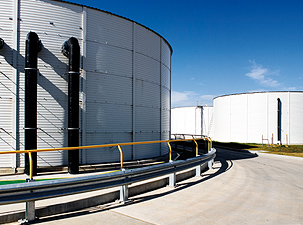ENVIRONMENT
MEETING CHALLENGES
Steel has many sustainable qualities. It is light, strong, 100 PER CENT recyclable and the material of choice in a number of key environmental projects.
One of the major challenges facing the steel industry is meeting the changing environmental expectations of our communities. In Australia and New Zealand, climate change has become an issue of greater public concern and the governments of both countries are engaged in the development of emissions trading schemes for greenhouse gases. Subsequent to the close of the financial year, the Australian government released a Green Paper calling for public consultation on the design of a national emissions trading scheme.
By the end of this calendar year, a White Paper outlining policy and draft legislation will have been released. In 2010, a Carbon Pollution Reduction Scheme is scheduled to commence. The proposed scheme involves the Government setting a cap on Australia’s carbon emissions. Companies will need to acquire a permit for each tonne of greenhouse gas (CO2-equivalent) emitted. These permits can be traded on an open market and BlueScope Steel may be eligible for transitional assistance in the form of free permits. While there are areas where BlueScope Steel can reduce emissions, we are ultimately limited by the chemistry of the iron and steelmaking process, where carbon dioxide is a product of the reduction of iron oxide to molten iron.
This process accounts for nearly all greenhouse gas emissions from blast furnace operations.
Therefore, a technological breakthrough in the fundamental iron and steelmaking process is required if steel producers are to achieve reductions in carbon emissions beyond current limits. BlueScope Steel is involved in the International Iron and Steel Institute’s CO2 Breakthrough Project, which is researching lower emission steelmaking technologies.
Our Company will continue to work closely with the Australian Government to develop a Carbon Pollution Reduction Scheme that supports the long-term competitiveness of Australia’s iron and steel industry. Wherever economically and technically practicable, we will be investing in new technologies and equipment to reduce our carbon intensity.
In New Zealand, it is proposed the iron and steel industry will be covered by an Emissions Trading Scheme from 2010, receiving 90 per cent free permits in transitional assistance until 2018. As a trade exposed industry, New Zealand Steel is working closely with the New Zealand Government to secure an appropriate outcome.

Major environmental projects
During the year, we continued a feasibility study into a co-generation plant at Port Kembla Steelworks. The plant would use surplus gas from iron and steelmaking to produce electricity and steam. This project has the potential to offset over 800,000 tonnes of greenhouse gas emissions per annum in New South Wales by reducing the Steelworks' demand for coal generated electricity from the grid. At a cost of around $1 billion the co-generation plant would be one of Australia’s largest greenhouse gas abatement projects, and its viability depends on a supportive regulatory environment.
The drought affecting much of Australia has led to increased water restrictions and far greater focus on water conservation strategies. At our Western Port operation, work is continuing on a joint project with South East Water and the Victorian Government. This project involves the construction of a 13 kilometre pipeline to direct recycled water to our Western Port plant, reducing its annual fresh water consumption by more than 60 per cent, or 660 megalitres per year (equivalent to the annual water consumption of 3,000 households).
At Port Kembla Steelworks, water saving initiatives in recent years have halved fresh water consumption. Ninety-eight per cent of water used at the Steelworks is now either recycled or salt water.
Environmental policy and sustainability
During the year, BlueScope Steel developed a set of principles that underline our commitment to the environment. These principles cover five areas of environmental responsibility – reducing greenhouse gas emissions, reducing land, air and water pollution, reducing waste sent to landfill, optimising material reuse and recycling and conserving energy and fresh water. In addition, our policy states the expectations we have of our sites, our managers and our employees in continually improving our environmental footprint.
The BlueScope Blueprint identifies sustainability as one of the eight ‘Basics’ or objectives. In this context, steel has many positive environmental attributes – it is light, strong and 100 per cent recyclable. Steel also features in important environmental projects and products, such as wind towers and rainwater tanks.

